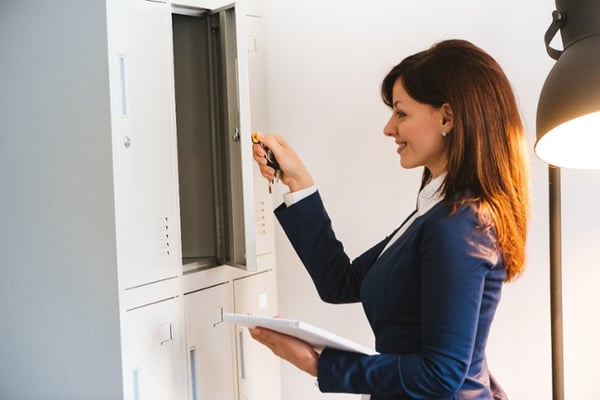Hot desking has become a popular practice for growing companies as a way to save money, improve efficiency, and create a more agile work environment for their employees. Office space can be costly, and frequently underused in more traditional office models. Hot desking takes advantage of today's growing workplace agility to help companies save money by moving away from the 1-to-1 seating model in the office. Rather than have assigned desks, employees operate from an open workspace, where they can reserve a desk on the spot.
Hot desking guidelines
One of the primary objectives of hot desking is to save office space. Workers can easily get a desk when they need one - by booking any desk that becomes available, rather than being assigned a specific workstation or seating area. Hot desking aims to optimize space efficiency, increase flexibility, and minimize unused office space.
Done properly it has the ability to be more convenient and flexible for employees, while also reducing waste and saving companies some considerable money. This is because of the rising costs of corporate real estate and the underutilization of space in traditional offices. On the other hand, hot desking can also be a chaotic free-for-all if done without the proper policies, rollout, and supporting technology for hassle-free hot desk management.
Not sure how to implement a hot desking plan without unleashing madness? Our comprehensive guide tackles everything from cultural changes to booking and hot desk management as well as other logistics.
How to manage the change
Implementing a hot desking system in your workplace requires more than just an announcement and several sign-in sheets at each desk. Making the transition from a 1-to-1 seating arrangement to a more mobile, active and open workspace design is a big cultural shift for employees. It definitely demands a thoughtful and well-constructed rollout.
As with most company-wide changes, getting your employees to buy into new ideas is essential. Here are a few tips to get your staff on-board.
Be honest about how this will change their work life
Yes, employees are going to have to give up some individually “owned” space, and that can be a difficult battle to fight. Therefore, be clear on how the change affects their daily routine and internal processes. Be sure to lead with the benefits - emphasize that hot desking means upgrading office technology and infrastructure; it provides greater flexibility and autonomy for employees; more functional workspaces; and improved relationships and collaboration with coworkers. When introducing new workplace changes, having the correct agenda can help you communicate the information in the best way possible and leave employees optimistic about the future.

Run a pilot
Hot desking can be complicated to organize and implement, and inevitably, there will be hitches along the way. Consider piloting the program in one building, on one floor, or among a select number of departments who would most benefit from the switch. This will help you work out kinks and policies, before rolling out company-wide.
Get feedback and input
Staff feedback and input is essential to successfully pulling off the change to hot desking. Encourage staff to speak up with questions, concerns, and suggestions and take them seriously. Not only will you get some potentially great ideas and FAQs on the table, employees are also more likely to support something they had a hand in shaping.
Getting the employee experience right
Hot desk management is essential for providing a seamless employee experience. Managing the employees needs allows them to access everything they need to work, regardless of the desk they use each day. Investing in adjustable workstations, remote and travel-friendly technology, and cloud-based services can help facilitate this process.
It's crucial to gather employee feedback when implementing a hot desk management solution. It's not just about the physical setup, but also how the system impacts daily interactions. Are there enough desks available? Does the system promote remote work? Are employees equipped with the necessary tools and resources to complete their tasks? These questions must be considered when developing the employee experience.
Here are a few key things to keep in mind during the transition to hot desk management:
Not everyone needs a hot desk
In order for hot desking to work, most employees across your company should be participating in the new system. However, certain key administrative staff like receptionists and HR will still need a permanent workspace set up. Avoid too many exceptions to the hot desking rule, and be thoughtful about who needs to stay in assigned seating.

Variety is key
The transition to hot desking has so much potential to transform your entire office. Hot desking is not just about saving money and using space more efficiently – it is about creating a more agile and activity-based workspace. Think about what kinds of workspaces your employees might need in absence of a dedicated desk and provide a variety of bookable and shared workspaces – desks, private offices, meeting rooms, huddle spaces, open kitchens, phone booths, and other alternative spaces to meet and work.
Provide ample storage
This is a simple but often-overlooked element of the transition to hot desking. Since your staff no longer have a permanent place to store personal items, they should have access to secure storage options where they can safely store their personal belongings while they work. This can help to create a more organized and professional workspace, while also ensuring that employees feel comfortable and supported in their work environment.

Have an etiquette policy in place
We’d all like to think an agreement on basic desk etiquette isn’t necessary, but without a clear policy, you’ll find your hot desking system in disarray– food and coffee stains, squatting in unreserved desks, spaces being used for inappropriate or inconsiderate purposes. Even having a few simple rules in place can have a big impact on employee cooperation, and allows everyone to hold each other accountable to the same standards. At the very least, an etiquette policy should include notes on proper booking, where and how to store personal items, and a cleanliness standard.
When used in the proper office setting - to support a flexible work strategy, a collaborative workspace, or a hybrid workplace model, hot desking can be a successful workplace strategy. However, its implementation is a continuous process. It takes time to monitor desk usage and make sure that the hot desks that are available meet your team's demands. Hot desking has a wide range of advantages for both team members and customers of the company - from promoting hybrid work to enhancing space efficiency, generating cost savings, and boosting employee engagement. Hybrid work and hot desking go hand in hand. But without the proper equipment, it is challenging to make it function effectively.
Invest in the right tools and tech
Successful hot desking requires the right tools and technology to work well, period. From messaging apps and cloud-based services to monitors, keyboards and dongles, your employees should have everything they need in order to have a productive day at any desk in the space. And while accessories and details laptop stands and ergonomic chairs are useful additions, an easy to use and intuitive booking systems is one of the most investments to make.
Track workspace utilization with analytics and insights
Invest in workplace utilization analytics to optimize your hot desk management. This tool provides valuable data and insights to help understand how the workplace is being used, including identifying underutilized areas. Use this information to allocate resources and improve the overall employee experience. Also, reduce real estate costs by repurposing or eliminating underutilized spaces. Strategic investments in workplace resources can be made using insights from the tool. For instance, if analytics reveal high demand for phone booths or huddle rooms, invest in more of these spaces to enhance productivity rather than having less used hot desks in the office. Workplace utilization analytics enables data-driven decisions to optimize the workplace experience, reduce real estate costs, and enhance productivity.
Improve the hot desking experience
How much time is lost on employees searching for an open desk, combing an unfamiliar landscape to find the right conference room, or hunting down extra chairs? The perfect hot desk experience can seem like an elusive concept, but it does not have to be. AskCody’s comprehensive meeting management and room booking technology now includes the ability to reserve hot desks on the spot in the same user-friendly interface with the Outlook add-ins.
Fully integrated with Outlook, Microsoft 365, our add-ins can help you do so much more than book hot desks and meeting rooms. With the AskCody software, employees can access a full suite of office resources like huddle rooms, open lounge spaces, meeting rooms, and phone rooms across multiple locations and time zones by simply opening Outlook.
It helps workers be more agile, productive and collaborative. Easily can search and sort by purpose, such as “hot desk” or “video conferencing,” and reserve specialized equipment or order catering in advance; move from your desk to an open brainstorm space and into a private meeting room as-needed.
For the offices transitioning into a more flexible and collaborative workplace model, AskCody’s Add-ins are an essential tool that eliminates inefficiency. Learn more about how AskCody can help improve the hot desking experience at your office:




